As has been consistently proven here at RG over the past year and a half, I am a big fan of Cadillacs (and Lincolns, and Imperials, and Olds 98s-never mind, we’ll be here all day!) I am especially enamored of the triple-yellow Cadillacs that were available between the late ’70s and early ’90s. And while the 1986-1991 Eldorado and Seville are a favorite target for half-baked blogger hit pieces, I do have a soft spot for these Mini-Me Eldos. Especially the restyled and re-engineered 1988-91 models. So when I saw what may be the best ’91 Eldo in existence, and in triple Cameo Ivory, I could not help but share its Broughaminess with all you fine folks.
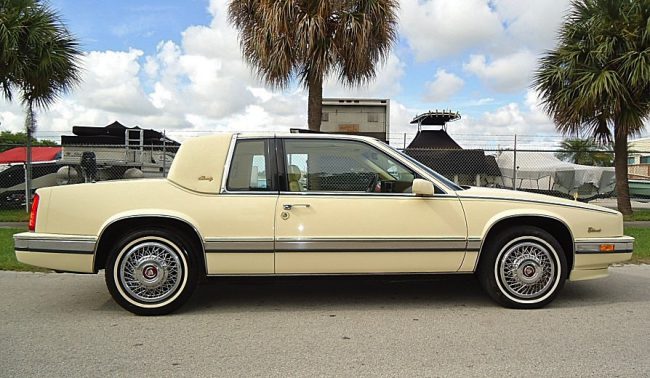
Yes, GM stumbled, scrambled and raced to redo their cars in the Eighties, thanks to changing tastes, CAFE and myriad other things. The second-gen downsized Eldorado got off to a rocky start, with shrunken proportions. Of course, when these cars were designed circa 1981 gas was expected to hit $5 per gallon. If that had indeed occurred, these cars would likely have found far greater success. But gas got cheap, GM kept their biggie B-and C-body luxocruisers in the line, and the E-body coupes saw lackluster showroom interest.
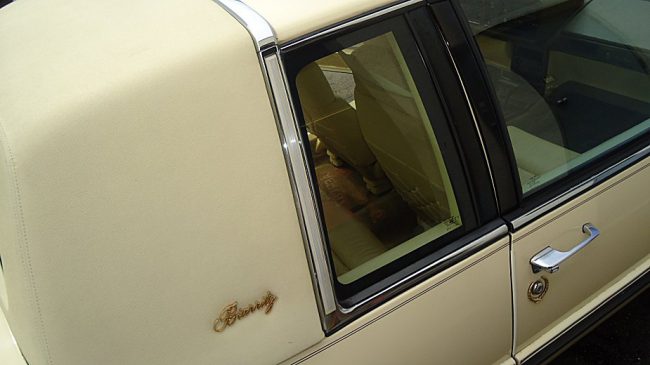
But added length and a more robust 4.5-liter V8 debuted for ’88, and made the Eldo so much better. The 1986 chassis was quite sound, providing great handling and good interior room. With the 1988 model, the tepid 4.1L V8 disappeared for good, and we all said hooray. As a result, production of the 1988-91 Eldos increased, and the revised edition of this generation carved a nice little niche for itself.
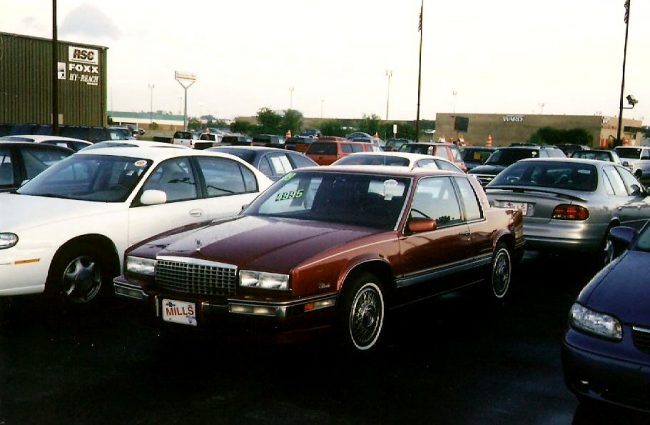
These cars were exceptionally peppy with the 4.9L V8. Back in 1999, when Facebook, smart phones and American Idol didn’t exist, and mastodons were still occasionally spied outside of Des Moines, I test drove a Garnet metallic 1989 Eldorado at Mills Chevrolet in Moline. It was a blast to drive, plush and fast. The burgundy leather seats were terrific, and there was ample glass area as well. Should have maybe gotten it, but I had no place to put it and no reason to have it.
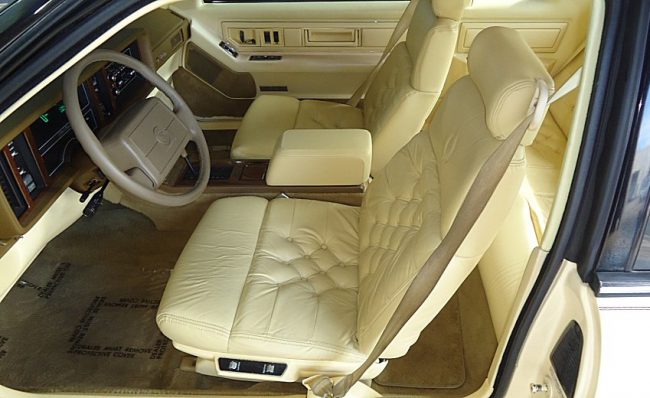
Model year 1991 was the swan-song for this Eldorado generation, but the new multi-port 4.9-liter V8 was a fresh talking point about for all front wheel drive Cadillacs. It did result in even more spirited performance, although the Eldorado’s older buyer base may never have noticed. The king of the Eldos was the Biarritz, with its button-tufted leather seating, extra chrome and landau roof. 1991 was the last year for the Biarritz; starting in 1992 the top of the line Eldorado would be the Touring Coupe.
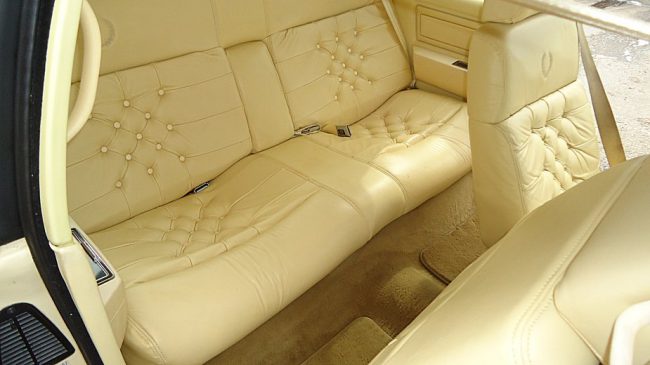
Amenities included such traditional American luxury car features as the aforementioned Saul Goodman office interior decor, electroluminescent opera lamps in the C-pillar, chrome side spears that wrapped over the roof and down the fenders, wire wheel covers and the uplevel Delco-Bose sound system.

My friend Carmine had this to say about this generation of Biarritz:
What I find funny about these is that there is a battle royal (Royale?) between looking modern and techy and slightly sporty with traditional and Broughamy going on in this car, its like “Brougham to Future.”
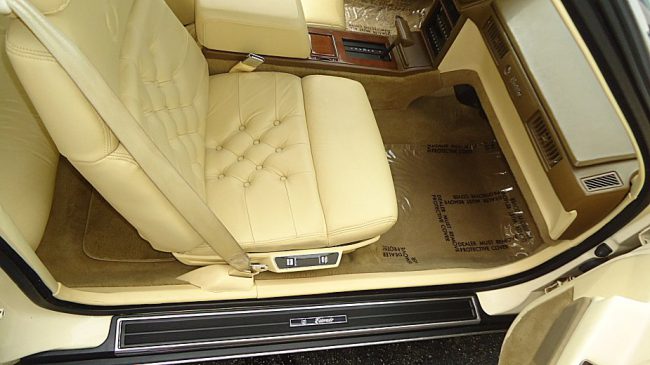
Buckets and operating console, next to button tufted pillow seats? Its like a white patent leather Nike running shoe with gold buckles. Same on the outside, where they tried to hold on to ALL of the traditional Eldorado styling cues, on a 1/4 scale car, even down to the little angled lamp monitors mounted much higher up on the fenders that ever before on a Cadillac, so they could still be seen even though the nose was lower and rounder. The Biarritz top is a study on its own, with its 2 foot long electroluminescent coach lamp, as if this car came from an alternate future where all that bric-a-brac that was still hip.
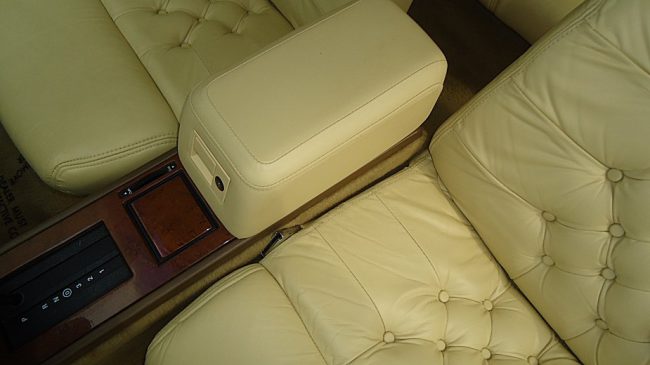
I spotted this showroom-new example on eBay in September 2013, and was smitten. I immediately added the pictures to “The Vault,” as my digital Brougham photo collection is commonly referred to. It was a real time capsule with 65,000 miles.
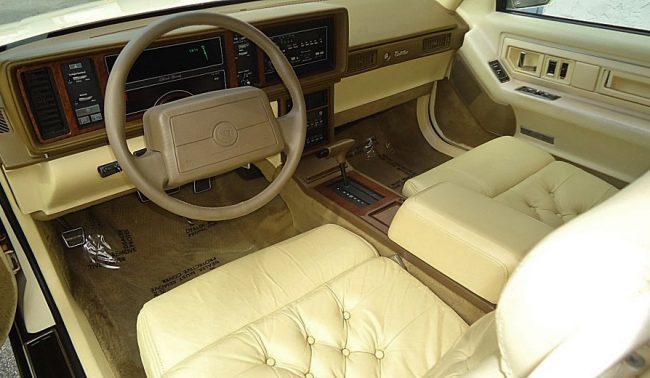
It appears the back seat has never been used, being just as nice as the rest of the car. Only 16,212 Eldorados were built in 1991. As previously mentioned, 1991 was also the final year for the Biarritz trim level, a Cadillac name that went all the way back to 1956, when it designated the Eldorado convertible when the Eldorado Seville hardtop joined the Cadillac line.
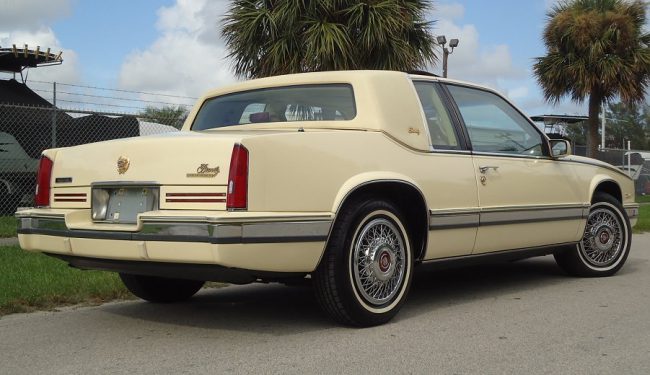
When all was said and done, this fine example sold for a mere $5200. A steal, by any standard. I hope the owner preserved it!
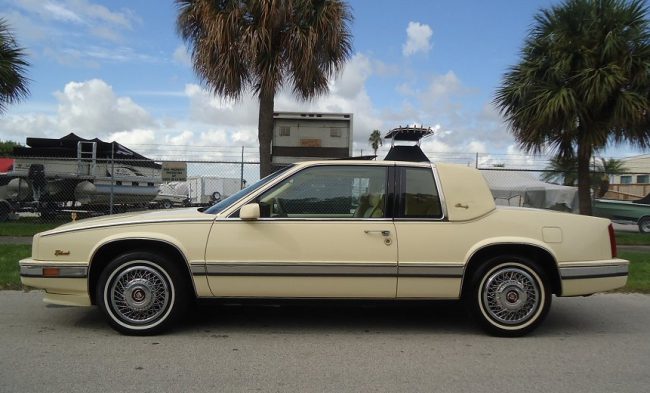
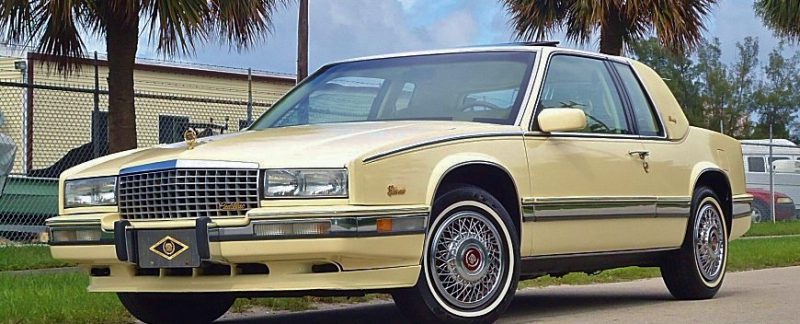

Thanks Tom and Carmine for treating this car respectfully. I always had a soft spot for the 88-91 as they got way more stylish without putting back on the bloat. Thanks to you my fondness has a catch phrase, “Brougham to future”.
Great write up Tom! What a nice Eldo it is, too. And Carmine nailed it – a true mix of old and new. These are a blast to drive, and were actually great cars for the time. It was consumer “snobbery” and previous expectations that made them not sell as well as they should have. As nice as they are, they lost that “look at me I’m driving an Eldorado” prestige that the previous generation exuded so perfectly. I can’t really blame the American public either. I myself back then felt they were lacking in the prestige department. Only after a few years of seeing them on the road did they grow on me, and the previous generation started to appear huge and outdated.
This is the car that Cadillac should have had when the downsized Eldo was launched. Why it took them 10 years to boost the anemic 4.1 to a respectable 4.9 is simply beyond any rational decision process, particularly since the difference in fuel economy was nothing.
It was perfectly respectable by the time it was a 4.5 in 1988. Even before then it was pretty special to have a lightweight V8 transversely in the front drives. Lincoln took 10 more years and never happened at Chrysler or Acura.
Acura’s sub par “Legend” 2.7 90 degree V6 was so lacking in torque that Austin/Rover who was stuck with it for its Sterling set to work on a Tickford turbo so there could be an actual performance model in the 800 range. The V6 had none even after Honda added 200 ccs and the 4 valve per cylinder head that was Rover’s idea. None of this makes the reviews of the time because the writers all drank the same import lover koolaid, and Honda was only handing out manuals to test, which they hardly built. It is past time to set the record straight.
The most prestigious brand from the world’s largest automaker develops a new engine for the 1980s and its a low tech OHV, and so small (4.1) and low in output (135 hp) that an Eldorado couldn’t get under 13 seconds for the 0-60 run. But with 1949 technology, you might expect it to be reliable – nope – lots of problems that took about 6 years to fix when they finally upped the displacement to 4.5 liters and a whopping 155 hp. Yes the Acura 2.5 V-6 in the first Legend had anemic torque, but it also had 151 hp, modern OHC technology, and was bulletproof, which is pretty impressive considering Honda’s lack of experience with “big” engines and tiny size relative to GM. Acura (and Lexus) would have never had any success if GM had put some decent effort into their top-of-the-line cars in the 1980s.
You could just as easily put it that despite having to change the way they build cars Cadillac still found a way to give their buyers what they wanted, a torquey V8, not an anemic 90 degree V6 coupled to rough shifting automatic like you got from Acura, Lincoln. and Chrysler.
By then import buyers where going to rush at any offering from their beloved Honda. It is why the “Legend” was a success in the USA and only the USA. Since the Accords had neither torque, road noise control, nor adequate suspension travel, their buyers did not even know what they should be getting. A little cross shopping would have been a boon to Cadillac.
The problem is Cadillac didn’t give their buyers what they wanted. Cadillacs were supposed to be fast, but 1980s models were all slow or very slow. Cadillacs were supposed to be reliable and well built to justify their premium price, but for the most part they were unreliable and no better in quality than a Chevy (i.e. fake wood, plastic chrome, fake wire wheels). Cadillacs were supposed to have a big physical presence from flashiness and size, but the 1980s downsizing made them look like cheap N-bodies. Arguably the only thing that 1980s Cadillacs delivered was better fuel economy, which was never a concern of Cadillac buyers – only the concern of government regulators. Cadillac survived because people like my grandparents continued to buy them out of habit, but that loyalty became less and less common as new upscale offerings became available from Acura, Lexus, Infiniti, Volvo, Saab, BMW, Jaguar, MB, and Audi, even though many of these were also far from perfect they at least didn’t look like a cheap Chevy.
The 4.1L sucked from top-to-bottom. It was not an engine befitting a premier automotive brand. It was not a “torquey V8”, it was not reliable, and it didn’t even compare favorably to the V6s of the day.
The 4.5L was a major improvement. Especially in 1990 when its output increased to 180/245 or in the Allante where it was rated 200/270.
“The 4.1 sucked from top to bottom”
Indeed I do believe the injection apparatus was mounted above the engine with the exhaust leaving from the below rear. I don’t believe this was special and indeed was fairly standard. What was special was the torque and smoothness that no 90 degree V6 could match. This was a fun yammer off.
“It is why the “Legend” was a success in the USA and only the USA.”
Are you saying the HT4100 Cadillacs were a success outside the US? The only reason they had any success inside the US was because there were people conditioned to buy Cadillacs. The HT4100 cured most of them.
The 4.9 wasn’t a bad engine in and of itself, but it showed up too late to avoid being outclassed by 32-valve V8s from Lexus and Infiniti.
GM offered 3 V6s during the same period with equal or greater torque than the 4.1L V8 while providing better reliability.
The torque of the HT4100 is absolutely not “special” in any way unless you pretend the only other company that competed at the time was Honda/Acura. If the HT4100 was delivering legendary smoothness to make up for its weak output this is the first I’m hearing of it.
The Buick 4.1 with a four barrel and the Vortec 4.3 were not offered front drive transverse. The 3.8 Buick V6 was below the same year 4.1 V8. The V6s from abroad were not even close. So which do you mean and which year. Engineering a lightweight V8 that went front drive and was specially engineered for easy American style torque was a Cadillac exclusive. It may not have been important to every buyer, but the exclusivity was deserving to be recognized.
“So which do you mean and which year.”
In ’85 the 4100 made 125hp@4200 and 190lb-ft@2200 and in ’86 and ’87 the V8 made 130hp@4200 RPM and 200lb-ft@2200RPM.
For the FWD 3.8L V6, in ’85 it made 125hp@4400 and 195lb-ft@2000, 140hp@4400 and 200lb-ft@2000 in ’86, and 150hp@4400 – 200lb-ft@2000 in ’87.
Outside of the version in the big-dollar Allante, the FWD 4100 did not hold an output advantage over the V6 offered in the BOP cars.
Shades of the final STS, where you had a choice between the 3.6DI V6 and the lumpy Northstar, with both engines putting out similar numbers.
Never mind the Japanese didn’t figure out rustproofing until 1992 or so. Heck, Mazda and Nissan still haven’t figured it out. But whatever floats your boat…
I do think some portion of buyers in the 1980s (not all, of course) bought imports simply to spite their Greatest Generation parents. There was no way they were buying a Delta 88 like their dad had, or 98 Regency like grandpa. Like, that would be totally bogus, dude! And those folks are still buying them. The stereotypical little old man wearing a hat and driving 15 mph in town-who once were typically in various Oldsmobuicks-now are usually in a beige beigemist Avalon, CR-V or Camry LE.
From the comments, it just seems like a lot of torque to take you from 0-60 in 13 seconds. Or maybe the Greatest Generation used torque for something other than acceleration.
James
We got all a little distracted by the inevitable 4.1 V8 hatefest. This car was probably in the high 7s to sixty. It was not the type of car the magazines were into so there were not many retests as the horsepower and yes torque increased. The 13 second time was the early version of the engine in the previous heavier bodied car sold 82-85.
My point was the uniqueness of engineering a V8 to go with the CAFE led shift to transverse FWD. 90 degree V6s, some not yet balance shafted were the go to choice at Lincoln, Chrysler, Acura, and even eventually Audi. Many served adequately, but Cadillac must have had a fight to keep a unique engine. The 4.1 V8’s reputation was damaged when it was put in the earlier heavier cars for which it was not intended. The V8/6/4 big block was to take care of those with the 30 year ahead of it’s time cylinder deactivation getting the big cars through CAFE. This alas was a bridge too far. Cadillac, having just won the expensive argument that it deserved unique engines was stuck with just the 4.1 V8. The result looked more like market garden than the intended smooth and daring crossing at Remagen, but is hardly a tale of stupidity as it is often portrayed. It was rather Cadillac fighting within the system for better cars.
That car is gorgeous! Beautiful interior. And for some reason, I like the following generation better.
To the people comparing the V8 to the holy and almighty 3800, power and torque wise they may have been similar, but I bet the V8 was much more smoother than my dear friend the “paint shaker”.
Nice find, Tom. As time goes on, I become more of a fan of these Caddys. I was a bigger fan of the Oldsmobile Toronados from this time period. I had a lot more exposure to those and found them to be quite nice to drive. But, today, I think I could really go for an Eldo like this. The yellow really isn’t my bag, but this car is just so neat and pristine, I can’t fault it.
Still holding out for the ATS-V, when I can afford one…